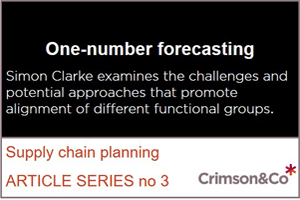Simon Clarke examines the challenges and potential approaches that promote alignment of different functional groups in forecasting.
Previously, I shared the importance of being clear about the purpose of the forecast and ensuring it aligns with the organisational mission. In this blog, I will discuss whether the objective of a forecast process is to arrive at a “one-number forecast”. The big idea is that this approach breaks down functional barriers and promotes collaboration. The benefit of this is a more streamlined, informed and efficient way to anticipate the future, saving time and money. But is this really true, and could there be a better way?

Functional silos are bad news for forecasters. This is because forecasting is an activity that is information dependent; it requires not only data, but also the information that gives the data context. For instance, a practitioner may be able to identify a spike in demand, but without context won’t have any idea why it happened. A second fundamental requirement of forecasting is the ability to assess and calibrate process inputs. If those input
s become politicised or subject to functional bias then the quality of the output can suffer.
What is the root cause of functional silos? They are one of the most common ways an organisation can choose to organise itself; using functional units where work is clustered into smaller groups around “like” work. For instance, all those in finance-related activities may be grouped together in a finance function. This can create operational efficiency through the sharing of resources, and the development of enhanced capability due to the concentration of specialised expertise. The disadvantage of this approach is that it can result in the creation of a deep-rooted functional ethos and tribe-like culture. This can lead to a suspicion of outsiders who do not share the identity and create a preference to huddle with their own. This functional mindset can result in the poor exchange of information and gives rise to organisational politics as resources and influence are vied for.
Solutions to this include the rise of less traditional organisational designs, such as the divisional or business unit which is organised to include all the necessary resources and functions to support itself. Matrix organisations have also emerged where groups are organised simultaneously by two operational entities. For instance, an associate may be organised by business unit but have a secondary functional reporting relationship.
The reality is that despite best efforts to eliminate functional silos, they still exist, even with less traditional organisation designs. For instance, in the business unit organisational design, associates can become so focused on their team they may become unaware or unwilling to share information pertinent to others.
Mindful of this, the conventional wisdom 20 years ago was to pursue the goal of “one-number forecasting”. The idea being that if you can’t eliminate the silos then create processes that force this collaboration and alignment. Simply put, without your own forecast you are forced to partner and come to consensus with others. This, however, brings me to Margaret Thatcher’s famous definition of consensus….
“…the process of abandoning all beliefs, principles, values and policies in search of something in which no-one believes, but to which no-one objects”
Clearly an extreme point-of-view, but with a kernel of truth in it. The pursuit of a single number, facilitated through the often dreaded consensus meeting, has typically resulted in a compromised outcome. This is often a forecast that is non-objectionable but leaves few with any great sense of ownership or belief in it. In its worst form it can be the outcome of horse-trading, which has little to do with arriving at a more accurate forecast. Significantly, it can also result in groupthink. It can have a distinctly chilling effect on forecasts that may appear unusual. Diverse opinions can end up being regressed to a more acceptable middle-ground, even though the more extreme view might be a more accurate representation of what might happen.
The other fundamental flaw of “one-number forecasting” is that it glosses over the fact that, more often than not, forecasts have different purposes depending on the functional group that needs them. For instance, a supply chain function is typically interested in the level of detail that is consumed in supply chain planning process (SCP). This is likely to be at a location and stock keeping unit (SKU) level. The finance function is interested in a more aggregate level of detail. They are less likely to be interested in the lowest level detail and more interested in the level at which products are priced or costed.
How the forecast is used is an important driver in how the forecast should be constructed. Many forecast support systems (FSS) lack the capability to simultaneously forecast at multiple levels, and then perform a process of optimal reconciliation to resolve the differences between the forecasts at each level. This results in practitioners having to make a fixed decision at what level they intend to forecast at and then, using a rules-based logic, aggregate or disaggregate the values they generate. Typically, a forecast that is consumed at a fine level of detail is created bottom-up and those consumed at a summary level is created from the top-down. The problem with a “one-number forecast” approach is that a single forecast methodology has to be employed, regardless of how the forecast will be used.
The problems don’t stop there. Different constituent groups have different forecast horizons that they are interested in. A strategic planning group may be more interested in forecasts that represent quarterly or annual buckets. An operations group may be interested in forecasts in daily buckets. If you want an accurate quarterly forecast, you would be well-advised to not aggregate daily level detail to a quarter. The forecast, by virtue of aggregation, would be extremely noisy and unrepresentative. Vice versa you wouldn’t want to take a forecast created in quarterly periods and disaggregate to SKU. This would create a forecast that would be unlikely to represent the underlying trends or seasonality in the data.
One of the final problems is that, by definition, different groups want to see different types of data. Someone in finance typically wants to see a forecast that represents what will be invoiced. This is typically different to the date on which the product was shipped or when payment was received. A supply chain professional doesn’t typically care about when the invoiced is generated but is interested in a projection of when the goods get shipped. This more directly affects labour and supply chain planning processes. In those organisations where goods are being shipped long-distances or there is latency between when the goods are delivered and when the invoice is generated, this is a significant issue.
The solution is to not constrain the creation of forecasts by constituent groups, but instead embrace the diversity each viewpoint brings and develop methods to connect them effectively. The goal, therefore, is to create a fully visible set of independent forecasts. This enables process participants to have forecasts that are constructed in a way that is most appropriate relative to how they are used, rather than being subjugated to a single forecast that they don’t buy into.
What are the prerequisites to support this approach? Firstly, it is critical that dimension hierarchies and temporal hierarchies can be reconciled. As discussed previously, there is a great sense in having different methods for forecasting to reflect the level at which the forecast is used, but it must be reconcilable at all levels. For instance, it must be possible to have a finance forecast created at an aggregate level to be disaggregated to a detail level. Vice versa, a SKU level forecast must be able to be aggregated to a summary level. The same applies with temporal hierarchies, a forecast created in daily buckets must be able to be aggregated to a week, month or quarter and so on.
The simplest way to achieve the goal of an aligned set of forecasts is through the use of a fit-for-purpose forecast support system (FSS). This creates the framework and data repository through which independent forecasts can be created and stored for review and retrospective reassessment. The key to this approach is to ensure that the temporal and dimensional hierarchies are created thoughtfully (more of that in a future blog). It is critical they meet the needs of all the participants.
What about the big elephant in the room, what if an organisation still insists on a single number forecast? This is still possible and, depending on circumstances, can have some advantages. The recommended approach is to combine forecasts, but not as output of the dreaded consensus meeting; a place where it is all too common for anecdotes and narrative to beat-out empirical evidence. Instead there should be a scientific method to take the independently generated forecasts and mathematically combine them.
One of the great benefits of a fit-for-purpose FSS is that it can enable this process with the use of rules. Probably the most common is to assess the historical accuracy or bias of each process participant at each dimension level and across each horizon. From this assessment it is possible to create a primacy rule to determine which forecast is to be used for which dimension level and horizon. Another option is to use a weighting rule that incorporates the inputs of all the participants, but with reference to their historic accuracy or bias. So, a forecast with 20% accuracy is weighted less prominently than a forecast with 80% accuracy. The other great advantage is that this can be an adaptive methodology, in other words it can self-adjust as accuracy changes.
The organisational benefits of these approaches is that deep domain, siloed knowledge, can be brought to the fore and included (or not) based on merit. All this contributes to engagement as participants are not forced to conform, nor are their inputs discarded. It also increases the speed at which decision making can take place – less time is spent debating and more time spent considering the decision that needs to be made. Meetings become more about making decisions on the basis of an aligned set of forecasts rather than about influencing others to one point-of-view or other.
Key takeouts:
- Do not try to use the “one-number forecast” approach to eliminate silos
- Seek ways to connect siloed groups effectively by allowing them to have their own forecasts, but with visibility to others so different groups can benefit from their insight
- Hierarchy design is a critical prerequisite to enable reconciliation of different forecasts,
- An important requirement of FSS’s is that the capability to capture multiple independent forecasts and can, if required, combine them into “one-number”
- Should “one-number” be required then ensure that the method to do so is empirically driven and is not one that can be unduly influenced by bias and unrepresentative narratives







